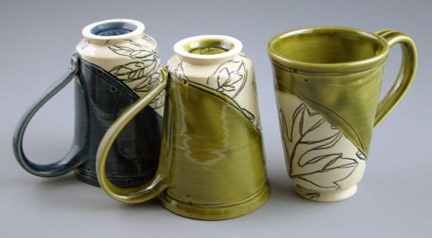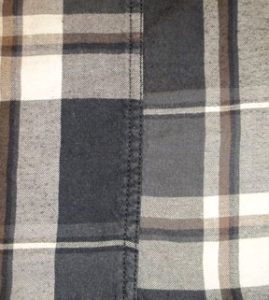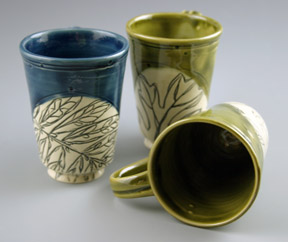details…details
 I sew. More accurately, I use to sew. A lot. When I was in high school, people even paid me to sew for them. I miss sewing.
I sew. More accurately, I use to sew. A lot. When I was in high school, people even paid me to sew for them. I miss sewing.
A few weeks ago I stopped by a national clothing chain, known for casual, trendy, west coast apparel on the cheap. They carry inexpensive tees and tops. I like them for work shirts because I tend to abuse clothes and don’t want to spend too much on what will soon be dusting the furniture.
After washing, drying and a few days hanging around the closet, I pulled one on – a simple, soft, relaxed, comfy tee. It wasn’t long before I realized something was wrong (is my shirt on backward?). My day was full of tugging and adjusting. So much for comfort.
I tried the others on. All ill-fitting. Including those with a slightly varied cut (ugh!). After closer inspection, I decided the manufacturer sacrificed the details of the garments to provide a product at a 2 for 1 price (it ain’t a deal if it’s uncomfortable).

With exception to the neckline, these tees appear to have the same cut, front and back. For the non-sewers, the front is cut different than the back because, though humans are symmetrical (for the most part) from side to side, we are more than a little different from front to back. Eliminating this detail compromised the integrity of the shirts. I could go on about loss of detail in clothing (whatever happened to inter-facings? stabilizers?), all of which affect the fit. I won’t…other than to say, plaids and stripes should match at the appropriate seams and every skirt should be lined. Details!
American author and publisher, William Feather (1889-1981) warned, “Beware of the man who won’t be bothered with details”. I can’t think of many life experiences for which this doesn’t ring true (you know…don’t take things at face value, read the fine print, know what you believe)! Concerning ceramics, the chasm between the student and the artist lies in the details.
One of the earliest pieces ceramic students learn to create is a mug. Mugs are very personal utilitarian pieces. Unlike a casserole which just needs to confine the potatoes, a mug needs to feel comfortable for the user.
The intimate nature of the mug demands attention to detail. For instance, handles need to be proportionately sized to manage the visual and actual weight of the piece, as well as the size of the hand holding it. You want to avoid that ‘stuck in a bowling ball’ feeling with a mug full of hot coffee. While we’re on handles, watch the placement. Too close to the rim and you’ll get poked in the eye with the thumb of your drinkin’ hand. Details!
 Also, the lip of your mug should be smooth. That gritty feel from grogged or sandy clay just points to a lack of compression when finishing the piece while the clay is wet. Since we’re on the subject, watch the thickness of the rim. Too thin and you’ll have a fragile, sharp edge. Too thick and you’ve got yourself a dribble cup. Details! One more oft overlooked detail, the diameter of the opening needs to be large enough to accommodate a nose.
Also, the lip of your mug should be smooth. That gritty feel from grogged or sandy clay just points to a lack of compression when finishing the piece while the clay is wet. Since we’re on the subject, watch the thickness of the rim. Too thin and you’ll have a fragile, sharp edge. Too thick and you’ve got yourself a dribble cup. Details! One more oft overlooked detail, the diameter of the opening needs to be large enough to accommodate a nose.
There are so many nuances that affect function and often drive design that I could go on and on. I won’t…other than to say, pay attention to the details.
8 Comments
Comments are closed.
I taken to getting all my tees at goodwill………..have to try them on, but they come pre-softened! I have a liking for ralph laren and bananna republic and anything thin and soft. Between the studio and my parrots my tees have a hard life! p.s. you have to look in the men’s section too………..$2.99
Enjoyed your comments. Coming from a long history of sewing, your comments resonated with me.
My granddaughter won’t go shopping with me anymore because she says I always comment on how poorly the garments of today are made, even the higher priced ones. I am especially appalled at the way they hem garments. Enough said. I agree, the details are important, until you can see the details of anything you do, you are not there in quality yet.
Oh Kathleen, you said it! I understand your granddaughter’s comment. In fact, I can hardly shop with myself…I get a little disgusted at the short cuts and poor quality.
Appreciating my mother a little more now, she made lots of our clothes for my two brothers and me growing up! Adding something concerning details, finish your bottoms nicely too!!! I can’t believe how many potters don’t bother sanding down the feet of their pieces, ruins a perfectly good pot.
I remember us all agonizing over that first mug and it’s paradoxical struggle between form and function. I think that is where the original WWJD bracelet was inspired…’What Would John Do” By the way, your mugs appear to have overcome that dilemma, beautiful. I could really become a coffee drinker with one of those!
Oh Michael, thank you for the kind words. I still find myself in a quandary with design…on most days. Indeed, What Would John Do?
Well said, on the importance of paying attention to the details, when making mugs. A few years ago, I thought I finally had the mug form down, that I really knew what I was doing. So, in my very first firing in my brand new electric kiln, I included an especially pretty mug to keep just for myself (while I try NOT to be a collector of my own work, I do occasionally make pieces just for me). I was very excited with the glazes, so I proudly took it to my office day job, for drinking water. Imagine my shock upon discovering how incredibly uncomfortable it was to use! It took my several days of “field testing” to realize what was wrong. My big, graceful, loopy handle was too big. The pivot point was too far away from the center of gravity. I had not even realized that mugs had a pivot point (the axis around which the vessel is rotated, when tilting to drink from it). It was downright embarrassing! How many uncomfortable mugs were floating around there? It sent me into a bit of tail spin, figuring out how to adjust it, but still have something that I liked, that represented my style. I did managed to adapt my design, eventually, but it was an important lesson.
It’s fun to collect other potter’s mugs, but nothing beats USING your own mugs to help you figure out your own choices on those tiny details that are so important.
Lisa, an occasional ‘quality test’ is a good thing. Several years ago while preparing a dish for a potluck, I was desperate for a large baking dish (silly how bare my cupboards are of service pieces). I grabbed a large casserole from the studio. Gotta say, I love to use that piece. I’ve made smaller ones – people usually ask for a smaller version. But the big one is so much better for baking and roasting.
Keep up the good work!